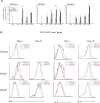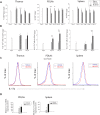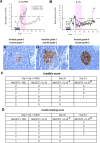Interleukin-35 administration counteracts established murine type 1 diabetes--possible involvement of regulatory T cells
- PMID: 26224624
- PMCID: PMC4519737
- DOI: 10.1038/srep12633
Interleukin-35 administration counteracts established murine type 1 diabetes--possible involvement of regulatory T cells
Abstract
The anti-inflammatory cytokine IL-35 is produced by regulatory T (Treg) cells to suppress autoimmune and inflammatory responses. The role of IL-35 in type 1 diabetes (T1D) remains to be answered. To elucidate this, we investigated the kinetics of Treg cell response in the multiple low dose streptozotocin induced (MLDSTZ) T1D model and measured the levels of IL-35 in human T1D patients. We found that Treg cells were increased in MLDSTZ mice. However, the Treg cells showed a decreased production of anti-inflammatory (IL-10, IL-35, TGF-β) and increased pro-inflammatory (IFN-γ, IL-2, IL-17) cytokines, indicating a phenotypic shift of Treg cells under T1D condition. IL-35 administration effectively both prevented development of, and counteracted established MLDSTZ T1D, seemingly by induction of Eos expression and IL-35 production in Treg cells, thus reversing the phenotypic shift of the Treg cells. IL-35 administration reversed established hyperglycemia in NOD mouse model of T1D. Moreover, circulating IL-35 levels were decreased in human T1D patients compared to healthy controls. These findings suggest that insufficient IL-35 levels play a pivotal role in the development of T1D and that treatment with IL-35 should be investigated in treatment of T1D and other autoimmune diseases.
Figures











Similar articles
-
Interleukin-35 Prevents Development of Autoimmune Diabetes Possibly by Maintaining the Phenotype of Regulatory B Cells.Int J Mol Sci. 2021 Nov 30;22(23):12988. doi: 10.3390/ijms222312988. Int J Mol Sci. 2021. PMID: 34884797 Free PMC article.
-
Ethyl Pyruvate Stimulates Regulatory T Cells and Ameliorates Type 1 Diabetes Development in Mice.Front Immunol. 2019 Jan 10;9:3130. doi: 10.3389/fimmu.2018.03130. eCollection 2018. Front Immunol. 2019. PMID: 30687329 Free PMC article.
-
Multiple mechanisms involved in diabetes protection by lipopolysaccharide in non-obese diabetic mice.Toxicol Appl Pharmacol. 2015 Jun 15;285(3):149-58. doi: 10.1016/j.taap.2015.04.006. Epub 2015 Apr 17. Toxicol Appl Pharmacol. 2015. PMID: 25896969
-
Th17 cells in type 1 diabetes.Cell Immunol. 2012 Nov;280(1):16-21. doi: 10.1016/j.cellimm.2012.11.001. Epub 2012 Nov 28. Cell Immunol. 2012. PMID: 23246831 Review.
-
Harnessing the power of regulatory T-cells to control autoimmune diabetes: overview and perspective.Immunology. 2018 Feb;153(2):161-170. doi: 10.1111/imm.12867. Epub 2017 Dec 11. Immunology. 2018. PMID: 29155454 Free PMC article. Review.
Cited by
-
Latent Autoimmune Diabetes in Adults (LADA): From Immunopathogenesis to Immunotherapy.Front Endocrinol (Lausanne). 2022 Jul 21;13:917169. doi: 10.3389/fendo.2022.917169. eCollection 2022. Front Endocrinol (Lausanne). 2022. PMID: 35937817 Free PMC article. Review.
-
Unique Features of Pancreatic-Resident Regulatory T Cells in Autoimmune Type 1 Diabetes.Front Immunol. 2017 Sep 29;8:1235. doi: 10.3389/fimmu.2017.01235. eCollection 2017. Front Immunol. 2017. PMID: 29033948 Free PMC article. Review.
-
IL35 modulation altered survival, cytokine environment and histopathological consequences during malaria infection in mice.Malar J. 2019 Dec 19;18(1):434. doi: 10.1186/s12936-019-3070-x. Malar J. 2019. PMID: 31856836 Free PMC article.
-
Interleukin-35 Prevents the Elevation of the M1/M2 Ratio of Macrophages in Experimental Type 1 Diabetes.Int J Mol Sci. 2022 Jul 19;23(14):7970. doi: 10.3390/ijms23147970. Int J Mol Sci. 2022. PMID: 35887317 Free PMC article.
-
Cytokines in type 1 diabetes: mechanisms of action and immunotherapeutic targets.Clin Transl Immunology. 2020 Mar 16;9(3):e1122. doi: 10.1002/cti2.1122. eCollection 2020. Clin Transl Immunology. 2020. PMID: 32185024 Free PMC article. Review.
References
Publication types
MeSH terms
Substances
LinkOut - more resources
Full Text Sources
Other Literature Sources

